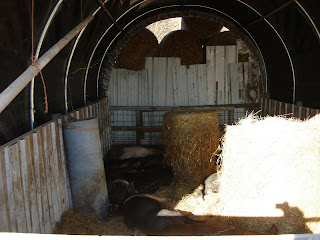
Above are the laying hens in their winter coop. The hoop house structure is layered with deep straw and the sided buried with snow when available. Waterers are pulled at dumped and removed at night to prevent freezing. The chickens are fed free choice organic layer mash. An average of one bird per four square feet is optimum stocking. Too many birds and issues arise with crowding and fighting. Not enough and the bedding pack and body heat from the birds doesn't provide enough heat during cold winter nights. No supplemental heat is added.
In the summer the layers are kept in egg mobiles built on movable trailers. Polywire net fencing is strung in a large circle around the trailers. The hens are allowed to free range on pasture during the day and locked in the egg mobiles at night to protect from predators. Badgers have been one of their biggest predators, killing as many as 90 birds in one night.

Above is the winter finishing hut for butcher hogs. The pigs in this hut are slated for their "bad" day within the next couple of weeks. After these are gone the young piglets on pasture will be move into the hut for the winter to finish. The sows will be breed back in mid December for April farrowing and are housed outdoors with a deep straw bedded hut. The sows farrow on pasture in the metal "port-a-huts". One more hut is needed than the number of sows farrowing.


Happy Cows! Intensive rotational grazing increases grass production and reduces disease in the herd. If you can see the cows eyes when they are grazing the grass is too long. If you can see their nose it is too short.

Loafing shed for butcher steers. Feed whole corn and hay, the bedding pack is built up throughout the winter. Corn, missed by the steers is scattered throughout the bedding. In early spring the bred sows are brought in to scavenge for the corn, mixing the bedding pack for faster decomposition. The bedding is then removed and composted further before applying to the fields.

Swedish style milking parlor. Milks 8 cows at a time. The only time the cows are inside is when they are being milked. No bending over to hook up milking machine. Total cost under $30,000.


 Kent rotates the cows through seven paddocks. Above is a winter manure pack area where cows are concentrated and fed round bales(notice the distinct line where manure stops). This area will be disked in the spring and planted to drought tolerant millet. This will be grazed twice then in August worked and seeded to triticale and field turnips undersown to a pasture mix of alfalfa, chicory and misc grasses. The cold hardy tritcale and turnips are fall grazed into Oct or Nov. After this the paddock is used as a winter feeding area to build manure pack. The following spring the established pasture mix that was undersown comes up through the manure pack. The paddock is left in pasture for 4 to 5 years before rotating back to millet.
Kent rotates the cows through seven paddocks. Above is a winter manure pack area where cows are concentrated and fed round bales(notice the distinct line where manure stops). This area will be disked in the spring and planted to drought tolerant millet. This will be grazed twice then in August worked and seeded to triticale and field turnips undersown to a pasture mix of alfalfa, chicory and misc grasses. The cold hardy tritcale and turnips are fall grazed into Oct or Nov. After this the paddock is used as a winter feeding area to build manure pack. The following spring the established pasture mix that was undersown comes up through the manure pack. The paddock is left in pasture for 4 to 5 years before rotating back to millet. 
Though hard to see this shows the 1-3" manure pack. Biologically active soils are needed for the microbes to break down this manure pack and incorporate it into the soil. This is especially important on light sandy soils like those on the Seven Pines farm.














































